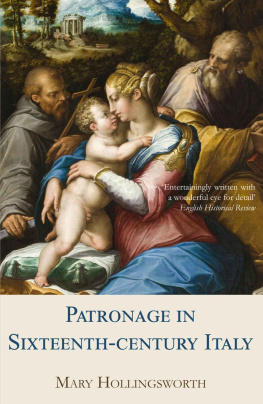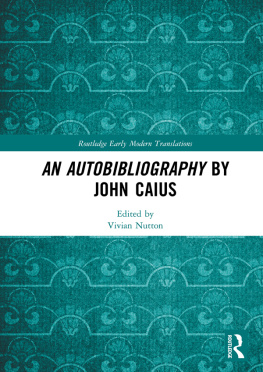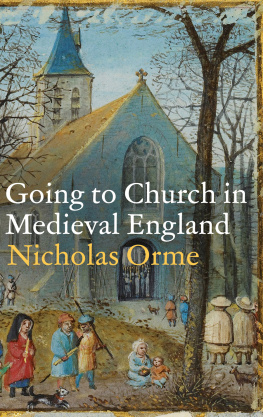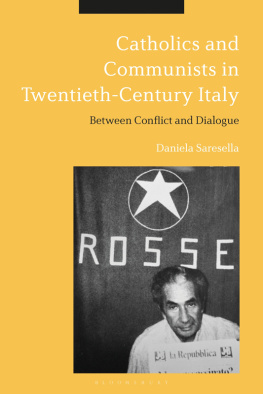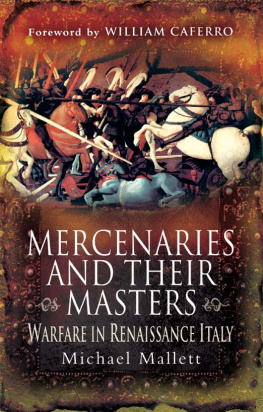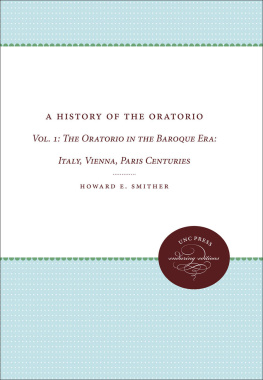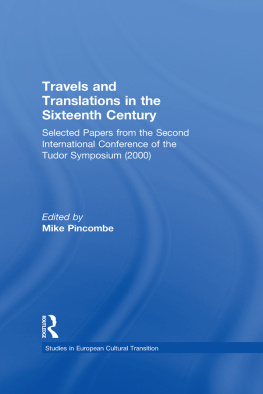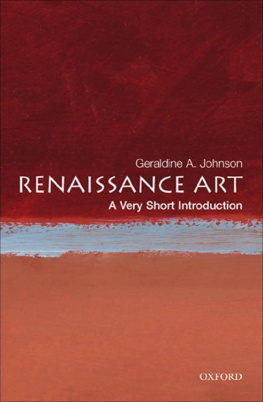Patronage in
Sixteenth Century
Italy
Mary Hollingsworth
All Rights Reserved
Copyright Mary Hollingsworth 1996
First published 1996 by John Murray
This edition published in 2014 by:
Thistle Publishing
36 Great Smith Street
London
SW1P 3BU
www.thistlepublishing.co.uk
For
Rosamund, Christopher and Camilla
Patronage of art is an exciting subject, increasingly popular not only as a field of academic research but also with the less specialized reader who wants to learn more about the men and women who commissioned the grand churches, magnificent palaces, villas and gardens decorated with statues, fresco cycles and altarpieces for which Italy is so justly famous. The sixteenth century was a momentous period in history and its patrons richly deserve investigation. While war, economic chaos and religious turmoil radically altered the political, social and religious life of Italy, the century witnessed unprecedented expenditure on art and architecture.
This was a century of famous patron-artist partnerships: Julius II and Bramante embarked on the monumental task of rebuilding St Peter's; Paul III commissioned Michelangelo to paint his celebrated Last Judgement; Sixtus V and Domenico Fontana transformed the urban fabric of Rome; Borromeo and Pellegrino Tibaldi introduced the ideals of the Counter-Reformation in an ambitious programme of religious architecture in Milan; the centre of Venice was dramatically remodelled by the city's government and Jacopo Sansovino; wealthy Venetian patricians built beautiful villas in the Veneto from designs by Palladio, and commissioned their portraits and altarpieces from artists of the calibre of Titian and Tintoretto. Giulio Romano built and decorated the Palazzo del Te for Federigo Gonzaga and, in perhaps the most famous partnership of all, Vasari gave visual expression to Cosimo I's ambitions in an enormous programme of building and embellishment that established Florence as a centre of artistic excellence.
This book is not solely concerned with the famous; it also includes less well-known patrons the guilds and confraternities that were such an important feature of urban life in the Renaissance, or the women whose Christian piety lay behind the decoration of many chapels in Rome and Venice, the wealthy bankers and traders who prospered in every Italian city and the new religious orders who zealously promoted Church reform in their churches, altarpieces and fresco cycles.
Here Dr Hollingsworth examines how patrons acquired their wealth, and how they spent it, why they invested so much in art and what factors governed their choice of themes and styles. She discusses the process of design and construction, and the complex relationships between artists, patrons, agents and advisers. Above all, she investigates the impact of political and religious change on the development of sixteenth-century art and demonstrates the extent to which patrons controlled the final appearance of their projects.
Dr Mary Hollingsworth is the author of Patronage in Renaissance Italy: From 1400 to the Early Sixteenth Century.
Cover illustration: Titian, Danae (Naples, Capodimonte: photo INDEX/Pedicini)
Contents
Illustrations
Acknowledgements
Amongst the many friends and scholars who have offered support, shared their ideas and inspired me through their publications, I would like to thank David Chambers, Melissa Chapman, Richard Cocke, Paul Davies, Sabine Eiche, Roy Eriksen, David Franklin, Christoph Luitpold Frommel, Charles Hope, John Kenyon, Julian Kliemann, Andrew Martindale, Sara Matthews, John Onians, Howard Reid, Clare Robertson, Richard Schofield and John Shearman. I would also like to thank Walter Kaiser and the staff at I Tatti for their kind hospitality. Finally, I thank Caroline Davidson, my agent, and Grant Mclntyre and Gail Pirkis at John Murray for their faith in the book.
The author and publishers would like to thank the Bridgeman Art Library, London, and the following institutions and individuals for permission to reproduce illustrations: Vatican Museums and Galleries, Rome, Plates 1, 4, 11; Galleria degli Uffizi, Florence, 2, 40, 43, 44, 45, 47; Museo e Gallerie Nazionale di Capodimonte, Naples, 3, 9; Giraudon, 6, 35; Villa Farnesina, Rome, 8; Cappella Paolina, Vatican, 12; British Museum, London, 14, 16; Prado, Madrid, 17, 42, 50, 54, 55, 56, 57; Christie's, London, 18; Palazzo Farnese, Rome, 19; Contarelli Chapel, S. Luigi dei Francesi, Rome, 22; Palazzo Ducale, Venice, 25, 26; Galleria dell' Accademia, Venice, 29 (photo: Francesco Turio Bohm), 30; Scuola Grande di San Rocco, Venice, 31; San Trovaso, Venice, 32; Kunsthistorisches Museum, Vienna, 34; Santa Maria Gloriosa dei Frari, Venice, 37 (photo: Francesco Turio Bohm), 38; Pio Monte della Misericordia, Naples, 41; National Gallery, London, 46; National Gallery of Ireland, Dublin, 48; Ali Meyer, 49; Palazzo del Te, Mantua, 52. We would also like to thank Clare Robertson for permission to reproduce Plate 20.
A Note on Money
The relationship between the various currencies in use in Renaissance Italy was enormously complex. Each of the peninsula's numerous states had its own system of coinage, weights and measures. Most states had their own gold-based coinage, which was internationally recognizable: the Florentine florin, first minted in 1252, was made of 3.53 grammes of gold, while the Venetian ducat, issued in 1284, weighed 3.55 grammes. These currencies fluctuated against each other in response to market forces and fortunes were made by cleverly predicting rises and falls in the exchange rates. To confuse the issue further, many states also had a silver-based coinage, usually known as the lira (1 lira = 20 soldi = 240 denari), which fluctuated against the local gold currency, offering further opportunities for profit and loss. Wealth was assessed in gold, the currency of international trade, while the silver coinage was used for everyday transactions, such as buying food and paying wages.
In this book I have used the gold-based currencies for expressing costs and, at a very basic level, it is possible to assume a broad similarity between the major gold-based currencies in use in sixteenth-century Italy, though it is important to recognize that they were far from interchangeable.
It would be misleading to suggest equivalents in modern money for sixteenth-century currencies, but typical earnings provide some guidance: a skilled worker would have earned about 100 ducats a year, a soldier 24, and a mathematics tutor 100.
Introduction
Renaissance society was vibrant, passionate and, above all, violent. Riots were common, so too were brutal attacks in city streets and in the countryside. Executions of thieves, forgers and bandits were customary. Suspected heretics were routinely tortured by the Inquisition and sentenced to the galleys or to burn at the stake. Catholics and Protestants massacred each other. Several cardinals were murdered, three kings of sixteenth-century France were assassinated, and another died in a tournament. Husbands killed their wives for adultery. Many men died in battle; many women died in childbirth. Diseases such as tuberculosis, malaria, typhus and smallpox were endemic; syphilis was new and spreading; and the plague, the ruthless scourge of Europe, killed hundreds of thousands of people. But there was also a lot of pleasure: Vasari described a dinner party held in a room decorated to look like Hell, with black devils as servants and a first course that seemed to consist of snakes, spiders, scorpions and other unattractive animals but which turned out to be delicious antipasti; after a dramatization of the story of Pluto and Persephone, which took place in the dark, the room was re-lit and the guests found themselves in front of a wonderful banquet.
Next page
